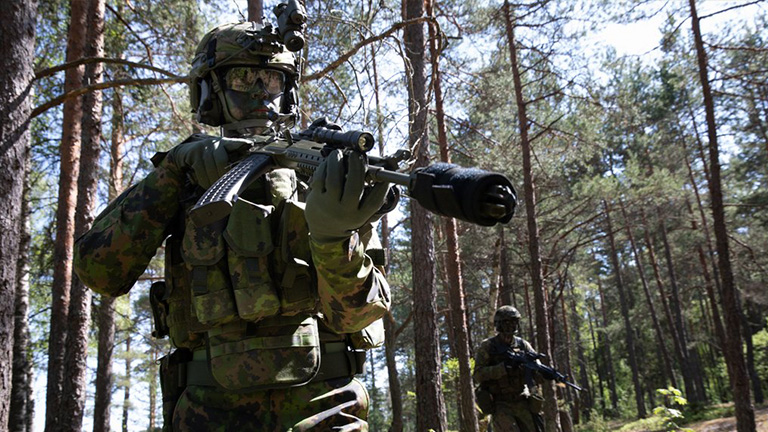Aiming for a Capable Soldier

The Finnish Army is responsible for soldier capability development in the Finnish Defence Forces through the Dismounted Soldier System Programme. Procurement that is based on long-term development helps us equip soldiers with suitable, fitting and capable kit that is suitable for Finnish conditions.
The Dismounted Soldier System Programme coordinates the soldier kit and weapon development, lays the foundation of the procurement and is responsible for the interoperability of materiel, both nationally and internationally.
The new acquisitions help improve the strengths of the soldier's kit and their overall equipment. Equipment development improves durability, protective and stealth capabilities, functionality and suitability for a conscription-based military. The goal of the development is a superior soldier for Finnish terrain.
Starting from Statement of Requirements
Material capabilities development takes years of hard work. Unit capability requirements are the baseline for development. The development includes research and experimentation that is used to refine concepts. With the help users and technical experts, the requirements are made into a statement of requirements, which enables materiel procurement. Field testing is used to make sure that the equipment is suitable for the soldier and the units.
Capability development is cooperation. It includes national and international defence industry, research establishments, the Army’s branch schools and the Defence Forces Logistics Command. The research methods and development are guided by constantly evolving international standards and close cooperation with NATO and partner countries.
“It takes approximately four to eight years from creating the statement of requirements to taking the materiel into use. One example of this is building night-vision capability: the foundation for it was laid in 2016-2018 with the assault rifle modernization programme. The capability has been improved with the procurement of image intensifiers, laser sights and various lights. The work continues with helmet procurement and preparations for the procurement of thermal imagers,” says Inspector of the Infantry, Colonel Juhana Skyttä from Army Command Finland.
Capability Consists of Parts
Soldier capability consists of five areas of capability that we are constantly improving: Firepower, survivability, mobility, command and situational awareness, and sustainability.
Firepower is a soldier’s ability to destroy or to neutralize a target with available weapon systems. Effecting a target requires the ability to observe the battlefield, the ability to detect, identify and classify targets, the ability to pass on targeting information, the ability to engage the target and the ability to assess the effectiveness of the fire.
The Finnish Defence Forces has modernized the small arms of its first-line units to ensure compatibility with night vision and versatile sighting equipment. Additionally, we are procuring new capabilities for snipers: 7.62 Rifle System M23 and 8.6 Sniper Rifle M10, along with new spotting equipment, will increase both the reach and effectiveness of fire significantly. We have started significant small arms cooperation with Sweden: this will create the foundation for procuring a family of compatible small arms in the future.
Survivability is a soldier’s ability to survive on the battlefield against threats posed by the enemy and operating environment. A soldier must be able to move away from the weapon effect of the enemy, to survive it and to provide life-saving first aid on the battlefield.
Survivability is improved with the procurement of new body armour, helmets and ballistic inserts. Protective equipment and protective properties of soldier clothing provide protection against threats caused by the operating environment. The Finnish Army has begun the introduction of a new respirator mask to its units as part of the effort to improve survivability.
Mobility is a soldier’s ability to move and navigate using various methods during any time of day and in any kind of weather.
Equipment meant to improve mobility includes new deep-snow skis, snow shoes and sleds, and breaching kits and assault ladders meant for improving mobility in an urban environment.
Command and situational awareness are the ability to receive, process, store, present and share information. The information allows the soldier to create an understanding of the surroundings, their own situation and that of their unit. Real-time situational awareness makes it possible to fully take advantage of all of the other areas of soldier capability in combat.
Command and situational awareness havebeen improved with night-vision gear, radios, soldier terminals and infantry drones.
Sustainability is a soldier’s ability to remain combat effective on the battlefield. A soldier must be able to survive during active combat operations on foot and without resupply from a few hours to multiple days, while carrying their weapons and ammunition, protective and communication equipment, sensors, power supplies, hydration and food. We are buying new load-bearing equipment and accessories that can be modified according to the task, and we will keep improving the equipment based on user feedback. From the start the development will be guided by load management, ergonomics and compatibility. This will help reduce the soldier’s physical and cognitive load.
Development Continues
A highly-trained infantry soldier continues to be at the heart of the fighting forces also in the future, and the development of their kit is an ongoing process. In a conscription-based military, soldier capability development is a coherent whole that is based on long-term development of its parts. Domestic research and development and international cooperation ensure that we meet the goals set for us.
The Army’s new soldier kit is built gradually, which allows for developing training and procedures, and integrating future technology with previously purchased materiel.
“The work is continuous, thanks to such things as rapid technological developments. Building the capability in small, cost-effective steps ensures that most of the capabilities are available immediately at any given moment. Domestic manufacture and security of supply play a key role in kit-and-weapon development,” says Inspector of the Infantry, Colonel Juhana Skyttä.



